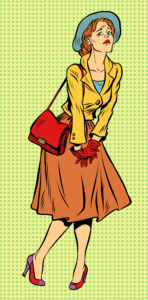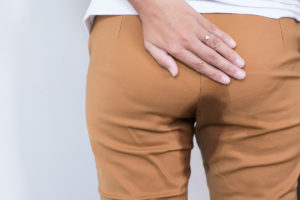Astellas compensated FOF with an advertising sponsorship to write this post. Regardless, we only recommend products or services that we believe will benefit the women in our community. Geri Brin, Founder, faboverfifty.com
The concert should have been a fun outing for Elaine and her young daughter, but it became a nightmare even before they left the car. “I had the urge to urinate and couldn’t hold it in another second,” Elaine recalls. Not wanting her “accident” to spoil the evening, she wore a sweater around her waist for hours while her clothes were drying. That’s when Elaine knew she had to see a doctor. In her late 40s at the time, she’d been living with overactive bladder (OAB) for about six years and it was affecting her quality of life more and more.

Characterized by frequency (needing to urinate eight or more times in 24 hours) and urgency, OAB can result in leakage if you don’t get to the bathroom in time.1 It occurs when your bladder contracts too often, even when it’s not full.2 “Instead of getting a first, second or final warning that you need to urinate, you get just the final warning, when the bladder is at maximum capacity. If it begins to contract before you make it to the bathroom, you may experience a leak,” according to Dr. Ekene Enemchukwu, a urologist at Stanford University Medical Center.
“The prevalence of OAB increases with age in both men and women.3 Almost 30 million people in the United States live with OAB symptoms,” Dr. Enemchukwu said.
Years before her accident at the concert, when Elaine started working at a call center, she had to ask her boss if her desk could be located closer to a bathroom. “Bathroom breaks were timed, and bonuses were based on the number of calls made each day and how long each one lasted,” Elaine remembered. But since she needed to use the bathroom two or three times an hour, she was afraid the job wasn’t going to work out. Elaine bit the bullet and told her supervisor about her issue. While it was embarrassing to discuss bathroom problems, Elaine luckily had an accommodating boss and kept her job.
ELAINE STOPS DOING WHAT SHE LOVES

As time went on, however, Elaine began to limit the activities she loved. She wanted to sign up for classes, for example, but she was concerned her frequent bathroom trips would distract the class. So she didn’t sign up. Her accident at the concert was the proverbial straw that broke the camel’s back. “I had been coping, but I wasn’t being proactive with my lifestyle,” she said.
Elaine may have thought she was coping effectively, but Stacy Kaiser, psychotherapist and relationship expert, calls it unhealthy coping. “Coping in general is how we go about dealing with any difficult change in our life, such as a family challenge, a financial issue, stress at work, or a medical condition,” Stacy said. “And coping with a medical condition such as OAB, which can be very embarrassing for some women, is especially challenging.”2

Elaine wasn’t coping successfully when she started avoiding activities she really wanted to do. Although she thought she was managing the situation by avoiding embarrassing moments, it wasn’t productive for her to withdraw from activities she enjoyed, Stacy said. People with OAB may isolate themselves from their support systems or social network,1 also a prime example of unhealthy coping. Healthy coping is finding ways to continue participating and engaging in your life, Stacy emphasized.
Once Elaine decided to reach out to a doctor, she was ready to shed her unhealthy coping habits and start taking charge of her life, rather than letting her condition take over. “Learning about a medical condition from a physician or medical expert helps give us the skills to get through challenging experiences in our lives,” Stacy stressed
A MEDICAL CONDITION THAT CAN BE MANAGED

“Many people don’t go to the physician’s office because they think OAB is a normal part of aging.2 Instead, they ignore the problem,” Dr. Enemchukwu said. They also find it difficult to discuss and don’t know how to bring up the subject up with their doctor. OAB patients can feel anxious, isolated and hopeless because they think there’s no way to address or fix a problem that has dramatically altered their lives.5
“Self-consciousness also stems from feeling like you’re the only person dealing with the situation and no one else will understand,” Stacy said. In fact, 39 percent of women with symptoms reported that OAB interfered with daily activities; 12 percent said their symptoms caused them to stay at home; 38 percent reported decreased physical activities and 34 percent attributed their weight gain to an inability to exercise.4 Sharing what you’re going through with others is key to helping you learn about OAB and can also provide emotional relief. Talking to friends and family and having a good support network are important, too.
It turns out that seeing a doctor was one of the best things Elaine could do for her emotional well-being, and for her OAB. She not only learned how common it is, but she also discovered it’s a medical condition that can be managed by behavioral, lifestyle and dietary changes and, in certain cases, prescription medications. Dr. Enemchukwu has a few recommendations:
- Pre-empt the urge: If you experience urinary leakage or frequency, try to get ahead of your symptoms when possible by remembering to use the restroom before you feel the sudden urge to go, or before heading to an outing or road trip.
 Be mindful of your fluid intake: Many patients believe that limiting fluids will help manage their OAB symptoms, but this can be problematic as it creates concentrated urine, which may be irritating to your bladder.5 It can also lead to dehydration.5 Your body needs water to function, so if you don’t drink enough, it will affect you in other ways.5
Be mindful of your fluid intake: Many patients believe that limiting fluids will help manage their OAB symptoms, but this can be problematic as it creates concentrated urine, which may be irritating to your bladder.5 It can also lead to dehydration.5 Your body needs water to function, so if you don’t drink enough, it will affect you in other ways.5- Avoid foods or drinks that can irritate your bladder: These include caffeine, spicy foods, carbonated fluids, citrus, tomato-based products, alcohol and tobacco.6 Keep in mind it’s important to talk to your doctor before making changes in your diet or exercise routine.
ELAINE’S HEALTHY COPING PLAN FOR A PROACTIVE LIFE
Now retired and living with her fiancé in Florida, 64-year-old Elaine said she lives a proactive lifestyle, refusing to let her OAB symptoms control her daily activities.
Planning ahead is important to her. Elaine keeps an extra outfit on hand when she’ll be out for hours and doesn’t drink too much if she’s going on a long trip. Often having a loved one at her side— namely her daughter— is a big support, she said. “We recently made the long drive north from Florida to New Jersey, and my daughter started looking for bathrooms on the road before I did since she knows I’ll have to make a lot of stops.” Elaine also relieves stress by listening to music and meditating and performs Kegel exercises to help strengthen her pelvic floor muscles.1 She advises anyone living with OAB symptoms to seek support from loved ones and health care professionals.
Passionate about helping other women with OAB to “enjoy their lives and have fun, not to let it overrule their lives,” Elaine has joined a new OAB awareness campaign called Coping Confessions, sponsored by Astellas. The campaign is brimming with online resources, including an online self-assessment tool that helps you become more aware of the way in which you cope, and “on-the-go” videos of women coping with OAB. To learn more about how you can assess your own coping behaviors and about overactive bladder, visit www.copingconfessions.com.
In a Coping Confessions video clip, Elaine joins experts on-the-go to share how she copes with overactive bladder
“We want to empower people to talk about their symptoms and to understand that healthy, productive coping is an important part of managing a medical problem, in addition to seeking expert guidance,” said Dr. Enemchukwu. “I’ve seen so many patients who have been dealing with OAB for decades, too embarrassed to talk to anyone about it, even their own family members or friends. Talking about OAB can reduce the stigma associated with this condition.”
WHAT CAUSES OAB AND HOW DO YOU KNOW IF YOU HAVE IT?
 Although the precise causes of OAB are unknown, it impacts both men and women, but occurs more frequently in women.4,7
Although the precise causes of OAB are unknown, it impacts both men and women, but occurs more frequently in women.4,7
If you believe you may have OAB, visit your healthcare provider so he or she can conduct a thorough evaluation of your symptoms and perform a physical exam. If you do have it, your doctor can help you take the right steps to manage your symptoms. Go to the appointment with a short list of your symptoms, which can help make the discussion productive. Make sure to give specifics, including:
➧ How many times you went to the bathroom in a given day.
➧ How many times you get up during the night to use the bathroom.
➧ How many times you had to change clothing because you leaked or had an accident.
➧ How many times you had to drop everything you were doing and run to the bathroom.
➧ Any activities you’ve avoided because you feared you may have an accident.
This article is not intended to be a substitute for professional medical advice, diagnosis or treatment. Always talk with your doctor before starting any diet or exercise program. This article is sponsored by Astellas.
___________________________________

